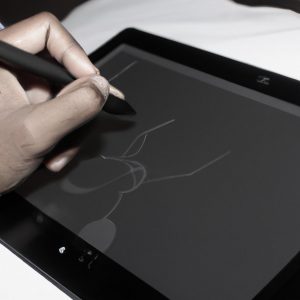Perspective in Arts and Comics: The Dynamics of Illustration

The use of perspective in arts and comics holds a profound influence over the dynamics of illustration. It is through careful manipulation of visual depth that artists are able to create an immersive experience for their viewers, guiding them into the world depicted on paper or canvas. By employing various techniques such as foreshortening, vanishing points, and atmospheric effects, illustrators can effectively convey spatial relationships and imbue their artwork with a sense of realism. For instance, consider the case of a comic book artist who skillfully employs one-point perspective to draw attention to a pivotal moment in the narrative. Through this strategic use of perspective, readers are drawn into the scene, experiencing heightened tension and emotional engagement.
Perspective plays a crucial role in allowing artists to manipulate space within a two-dimensional medium. With its ability to create illusions of depth and distance, it brings life and dimensionality to otherwise flat surfaces. The concept of perspective has been utilized throughout history by notable artists such as Leonardo da Vinci, Michelangelo, and Albrecht Dürer. These masters understood that by incorporating accurate perspective techniques into their works, they could achieve greater impact and resonance with their audiences. This principle still holds true today; contemporary illustrators continue to explore innovative ways to utilize perspective in order to enhance their storytelling and captivate viewers.
One of the key techniques in perspective drawing is the use of vanishing points. These imaginary points on the horizon line help establish the direction and convergence of lines in an artwork, creating a sense of depth and distance. By placing objects or figures along these converging lines, artists can create a realistic portrayal of space and give viewers a clear understanding of how elements in the illustration relate to one another.
Foreshortening is another important aspect of perspective that adds depth and realism to illustrations. It involves portraying objects or figures as they appear when viewed from a particular angle, often resulting in distorted proportions. By accurately depicting foreshortening, artists can create a convincing sense of three-dimensionality and bring their subjects to life.
Atmospheric effects are also commonly employed in perspective drawing to convey distance and depth. By using techniques such as diminishing detail, muted colors, and hazy backgrounds, artists can simulate the visual cues we perceive in real-life environments. This allows viewers to mentally place themselves within the artwork and experience a deeper connection with the depicted scene.
In summary, perspective is an integral element in arts and comics that enables artists to create immersive experiences for their audience. Through careful manipulation of visual depth using techniques like vanishing points, foreshortening, and atmospheric effects, illustrators can convey spatial relationships and imbue their artwork with a sense of realism. The strategic use of perspective enhances storytelling by drawing viewers into the scene and evoking emotional engagement.
The Role of Perspective in Art
The Role of Perspective in Art
Perspective plays a crucial role in the world of art, shaping the way viewers perceive and interpret visual representations. By creating an illusion of depth and dimension on a two-dimensional surface, it allows artists to bring their subjects to life, captivating audiences with visually engaging compositions. This section will explore the significance of perspective in art by examining its technical aspects, its ability to evoke emotions, and its influence on aesthetic appreciation.
To illustrate this point, let us consider a hypothetical scenario where an artist creates a landscape painting using different perspectives. In one version, they employ linear perspective, accurately depicting objects receding into the distance with vanishing points. In another version, they utilize atmospheric perspective, employing softer colors and lighter values as objects move farther away. The difference between these two approaches is striking – while linear perspective provides a sense of precision and realism, atmospheric perspective creates an ethereal atmosphere that evokes feelings of tranquility and mystery.
One can argue that perspective enhances emotional engagement by directing the viewer’s gaze and influencing how they experience a piece of artwork. For instance, when an artist uses converging lines or leading shapes to guide the eye towards a focal point within the composition, it can create a sense of focus or tension. Moreover, through careful manipulation of scale and foreshortening techniques, artists can emphasize certain elements over others to elicit specific emotional responses from viewers.
Emotional response aside, understanding perspective also contributes significantly to our aesthetic appreciation of art. When we recognize the skillful use of various types of perspective—such as one-point or two-point perspective—in artworks like architectural drawings or cityscapes, we gain admiration for the technical prowess required to achieve such accuracy and depth representation.
In conclusion,
As we delve deeper into the dynamics of illustration in arts and comics,
it becomes clear that
perspective serves as more than just a tool for achieving realistic depictions.
Its impact extends to emotional engagement and aesthetic appreciation,
allowing artists to elicit specific responses from viewers
and creating a sense of depth and dimension in their work.
Transition: Now that we have explored the significance of perspective in art,
let us turn our attention to its influence on comic storytelling.
The Impact of Perspective on Comic Storytelling
Building on the understanding of perspective as a key element in art, we now delve into its significance within the realm of comics. By examining how illustrators employ various techniques to convey depth and dimensionality, we can gain insight into the dynamic nature of illustration.
Perspective plays an integral role in comic storytelling by enabling artists to create visually engaging narratives that captivate readers. One notable example is seen in Chris Ware’s graphic novel “Jimmy Corrigan: The Smartest Kid on Earth.” Through meticulous attention to detail and skillful use of perspective, Ware constructs a rich visual landscape that heightens the emotional impact of his narrative.
To better understand the impact of perspective on comic storytelling, consider the following:
- Visual immersion: Utilizing one-point or two-point perspective allows artists to immerse readers into the world they have created. This technique creates a sense of depth and draws audiences deeper into the narrative.
- Emotional resonance: Strategic use of foreshortening and forced perspective can evoke powerful emotional responses from readers. These techniques manipulate proportions and angles to emphasize certain elements or characters, intensifying their presence within the story.
- Spatial dynamics: Employing multiple perspectives within a single panel can add complexity and movement to sequential art. By juxtaposing different viewpoints, artists can guide readers’ eyes across the page, enhancing both pacing and visual interest.
- Symbolic representation: Perspective can also be used symbolically within comics to convey themes or ideas. For instance, shifting perspectives may represent changes in character perception or illustrate shifts in power dynamics between characters.
| Techniques | Effects |
|---|---|
| One-point perspective | Creates a sense of depth |
| Two-point perspective | Immerses readers into the artwork |
| Foreshortening | Evokes strong emotional reactions |
| Forced perspective | Intensifies focus on specific elements |
Incorporating these techniques, comic artists have the power to manipulate perspective and shape narratives in unique ways. By exploring different perspectives within their work, they can effectively convey emotions, enhance storytelling dynamics, and engage readers on a deeper level.
Moving forward, we will now explore different techniques of perspective in art that further expand the artistic possibilities for illustrators across various mediums.
Exploring Different Techniques of Perspective in Art
Building upon the previous discussion on the impact of perspective in comic storytelling, this section aims to delve deeper into various techniques employed by artists to enhance visual impact through different perspectives. By examining these techniques, we can gain a better understanding of how artists bring their illustrations to life and engage readers on a more immersive level.
One example that highlights the power of perspective is the use of foreshortening. This technique involves distorting proportions to create an illusion of depth, thereby giving objects or characters a three-dimensional appearance. For instance, imagine a superhero soaring through the sky towards the reader; by skillfully applying foreshortening, the artist can convey a sense of speed and exhilaration while augmenting the overall impact of the illustration.
To further emphasize the significance of perspective in art and comics, let us explore its role in evoking emotional responses from viewers:
- Engagement: Through clever manipulation of perspective, artists can draw viewers into their world, instilling a sense of immersion and connection.
- Intimacy: Close-up shots with dramatic angles allow for heightened emotional intensity by focusing on facial expressions or conveying vulnerability.
- Dynamism: Dynamic perspectives such as extreme high or low angles add energy and excitement to action sequences, intensifying suspense and creating anticipation.
- Contrast: Contrast between foreground and background elements can be accentuated using varying scales achieved through perspective techniques, leading to visual interest and aesthetic appeal.
Additionally, employing multiple vanishing points – where lines converge toward different points on the horizon – allows artists to experiment with complex architectural compositions or depict intricate cityscapes. Consider a table comparing one-point versus two-point perspective:
| One-Point Perspective | Two-Point Perspective | |
|---|---|---|
| Features | Straightforward composition with all verticals parallel to each other | More dynamic and realistic compositions with objects appearing at angles |
| Usage | Often utilized for simple scenes or interiors | Commonly employed in landscapes, cityscapes, and complex environments |
By exploring the diverse techniques and effects of perspective in art and comics, we gain insight into the meticulous craftsmanship that goes into creating visually captivating illustrations. This knowledge sets the stage for our next discussion on the evolution of perspective in comic art, where we will delve into how artists have pushed boundaries to create even more engaging visual narratives.
The Evolution of Perspective in Comic Art
Transitioning from the previous section, where we delved into various techniques employed to create perspective in art, let us now shift our focus towards examining the evolution of perspective specifically within the realm of comic art. By exploring how artists have applied these techniques over time, we can gain a deeper understanding of how perspectives play a crucial role in shaping visual narratives.
To illustrate this point, let us consider an example from the world of comic books. In the critically acclaimed graphic novel “Watchmen” by Alan Moore and Dave Gibbons, the use of perspective is skillfully executed to enhance storytelling and evoke emotions. One notable instance occurs when Rorschach, one of the main characters, confronts his arch-nemesis in a dimly lit alleyway. Through clever manipulation of depth and foreshortening, Gibbons creates an intense sense of unease and tension that further immerses readers into the scene.
When examining different techniques utilized to convey perspective in comic art, several key aspects come to light:
- Foreshortening: This technique involves distorting objects or figures to emphasize their proximity to the viewer. It adds depth and realism to images while creating a dynamic visual impact.
- Point of View: By altering the angle from which a scene is depicted, artists can influence how readers perceive events unfolding within a narrative. A low-angle shot may instill feelings of dominance or intimidation, while a high-angle shot could elicit vulnerability or powerlessness.
- Panel Composition: The arrangement and size of panels on a page also contribute significantly to conveying perspective. Varying panel sizes can guide readers’ attention and establish spatial relationships between characters or elements within the artwork.
- Background Details: Thoughtful inclusion of environmental cues such as architectural elements or natural landscapes helps set scenes effectively. These details not only provide context but also aid in establishing scale and distance.
By employing these techniques, comic artists have the power to transport readers into their visual worlds and evoke a range of emotional responses. To further illustrate this point, let us consider a table that showcases how different perspectives can influence readers’ emotions:
| Perspective | Emotional Response |
|---|---|
| Wide Shot | Awe |
| Close-up | Intimacy |
| Overhead | Vulnerability |
| Worm’s Eye | Superiority |
In conclusion, understanding the diverse techniques employed in perspective drawing within the realm of comic art deepens our appreciation for its impact on storytelling. The deliberate use of foreshortening, varied points of view, panel composition, and background details enables artists to effectively convey depth, atmosphere, and emotion. Building upon this foundation, we will now explore the fascinating concept of utilizing perspective as a tool for evoking specific emotions in art.
Moving forward from our exploration of different techniques used in creating perspective within art and comics, we will now delve into “The Use of Perspective to Convey Emotions in Art.”
The Use of Perspective to Convey Emotions in Art
Imagine a comic book panel in which the hero is shown from a low angle, towering over the city skyline. This use of perspective instantly conveys power and dominance, enhancing the impact of the scene. In visual arts and comics, perspective plays a crucial role in shaping how illustrations are perceived by viewers.
Perspective serves as a powerful tool that artists utilize to create depth and dimension within their work. By manipulating vanishing points and horizon lines, illustrators can control how objects appear relative to one another, giving the illusion of distance or proximity. For instance, by incorporating linear perspective techniques, an artist can depict a vast landscape stretching into the background, immersing the viewer in its grandeur.
To further explore the dynamics of illustration through perspective, consider the following:
- Enhancing Realism: Proper utilization of perspective allows artists to bring life-like qualities to their creations. It enables them to accurately represent spatial relationships between elements within an artwork or comic panel.
- Guiding Viewer’s Focus: By strategically employing different types of perspectives such as bird’s-eye view or worm’s-eye view, artists can direct attention towards specific areas or subjects within their compositions.
- Conveying Emotions: Perspective can evoke emotional responses in viewers by altering their perception of characters and environments. A close-up shot with exaggerated foreshortening may elicit feelings of intimacy or intensity.
- Creating Dramatic Effect: Artists often manipulate perspective to heighten tension or emphasize action sequences. Dynamic angles and extreme viewpoints add energy and excitement to illustrated narratives.
To illustrate these concepts further, let us examine Table 1 below:
| Perspective Type | Definition | Emotional Response |
|---|---|---|
| One-Point Perspective | All parallel lines converge at a single point on the horizon line | Sense of stability and balance |
| Two-Point Perspective | Parallel lines converge at two separate points on the horizon line | Dynamic and immersive |
| Three-Point Perspective | Parallel lines converge at three different points, creating a sense of depth in all directions | Disorienting or surreal |
The impact of perspective extends beyond mere technicality. It influences how viewers experience illustrated narratives by shaping their perception and emotional response to visual storytelling. In the subsequent section, we will delve deeper into the influence of perspective on viewer experience, examining its role in fostering immersion and narrative engagement.
The Influence of Perspective on Viewer Experience
Section 3: The Impact of Perspective on Viewer Interpretation
Building upon the exploration of perspective’s role in conveying emotions, this section delves into how perspective influences viewer experience in art. By manipulating depth and spatial relationships within an illustration, artists can guide viewers’ understanding and evoke specific emotional responses.
One compelling example is the use of forced perspective in comic books to create dramatic effect. In a particular panel from “The Dark Knight Returns” by Frank Miller, Batman looms over a defeated criminal, with his figure exaggeratedly larger than life. This intentional distortion not only establishes Batman as a formidable presence but also accentuates the power dynamic between hero and villain.
To further illustrate the impact of perspective on viewer interpretation, consider the following points:
- Depth Perception: Through techniques such as foreshortening or vanishing points, artists manipulate distance perception to enhance realism or emphasize certain elements.
- Emotional Connection: Angles and viewpoints can be strategically chosen to establish intimacy or detachment between characters and viewers, eliciting empathy or creating a sense of unease.
- Narrative Focus: Shifting perspectives within sequential art (comics) allows for shifts in focus between different story elements or character perspectives.
- Symbolic Representation: Artists often employ symbolic distortions in scale or point of view to convey abstract concepts like power dynamics or psychological states.
| Perspective Technique | Example Usage |
|---|---|
| Overhead Shot | Conveys vulnerability or insignificance; commonly used when depicting crowds |
| Worm’s-eye View | Creates a sense of awe or dominance; utilized to highlight towering structures |
| Dutch Angle | Introduces disorientation and tension; frequently employed during suspenseful moments |
| Bird’s-eye View | Imparts an omniscient viewpoint; applied when showcasing large-scale environments |
In summary, perspective plays a pivotal role in determining how viewers interpret and engage with artwork. By skillfully manipulating depth, angles, and viewpoints, artists can guide emotions, establish narrative focus, and convey symbolic representations. These techniques not only enrich the viewer’s experience but also underscore the intricate dynamics between illustration and audience interpretation.



